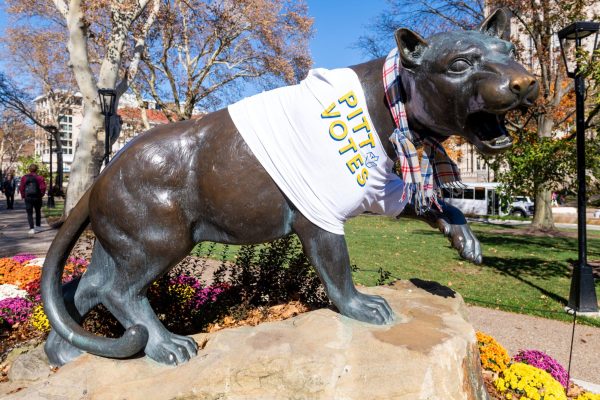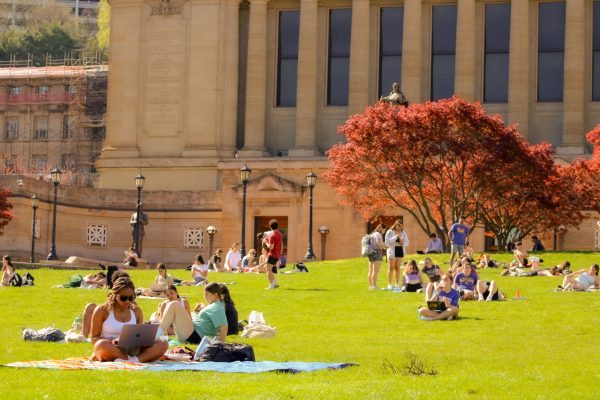Tans hurting teens, study indicates
September 25, 2003
Stephanie Pritchard, 23, began using tanning beds when she was 15, in anticipation of her… Stephanie Pritchard, 23, began using tanning beds when she was 15, in anticipation of her ninth-grade prom.
Today, she has a complexion so dark that it’s easy to mistake her ethnicity.
“I was known as not being a white person in high school, because I’d been tanning so much,” she said.
A recent graduate from Penn State University who currently works full time, Pritchard still manages to find room for a tanning bed session three times a week. While she hasn’t experienced any serious health repercussions yet, one group of researchers claims that teen-age tanning habits like hers are evidence that a large number of young women are gambling with the long-term health of their skin.
An estimated 36.8 percent of white, teen-age girls in the United States use tanning beds, lamps or other commercial tanning processes that utilize ultraviolet, or UV, light, according to a study by researchers at Case Western Reserve University. This suggests that many teens are, knowingly or not, risking skin cancer for the sake of sporting a good tan.
The study, which appeared in the September issue of Archives of Pediatrics ‘ Adolescent Medicine, estimated that 47 percent of college-aged, white, teen-age girls, and 28 percent of all white, teen-age girls, have been UV tanning three or more times.
The study found that the American Midwest, the area of the country with the fewest beaches, and the American South, the area with the most, are the most popular regions for UV tanning among teens.
At least 38 tanning salons – or hair and nail salons that also offer tanning – advertise within city limits, according to the Pittsburgh Yellow Pages.
“There’s no medically healthy benefit to using UV tanning beds,” said Dr. Douglas Kress, an associate professor and director of Clinical Dermatology Studies at Pitt. “By tanning, teens should know that you only increase your chances of contracting skin cancer and prematurely aging your skin.”
There are three types of skin-damaging solar light spectrums: UVA, UVB, and UVC. The earth’s atmosphere blocks out UVC rays. UVB rays are responsible for sunburns – a natural warning alarm of too much sun – while UVA rays cause tanning – the pigmentation of skin without visible burning.
Tanning beds, which first gained popularity in the 1970s, reduce UVB levels and rely on UVA to achieve results. While the process helps to give a tan without the burn, according to Dr. Kress, it concentrates cancer-causing radiation on the skin, also causing it to age prematurely and show pronounced wrinkles and freckling earlier.
“I deal with plenty of college-aged people – 20, 21 years old – who have already developed various skin cancers through [UV] over-exposure,” Kress said.
According to the American Academy of Dermatology, teens receive around 80 percent of their healthy lifetime sun exposure by the time they turn 18.
“I’m not sure why we feel the need to tan,” Pritchard said. “I guess we think we look better being tan. It’s like, once you get one tattoo, you want a lot more.”
Although teens in the Case Western study tanned predominantly for beauty reasons, the study found that continued tanning, both indoor and outdoor, resulted in damaged skin by or before the time tanners reached middle age.
Many teens in the study also said tanning booths attracted them because the salons promoted the booths as being safer for skin than natural sunlight.
“Every time we’d go there, they’d say, ‘Oh, it’s a lot safer than the sun,'” Prichard said. “I don’t know if it’s true, but I still went.”
“I couldn’t drive yet – I was 15,” she added.
Texas and Tennessee recently passed laws to inform teens of tanning bed risks and to require a parent’s consent before they can use the beds.
The Indoor Tanning Association, which represents commercial tanning bed operators around the country, has criticized the study’s findings, particularly the suggested connection between tanning beds and cancer.
Members have argued that publishing such a study will create only the unhealthy result of scaring people out of getting any UV light at all, either inside and outdoors.
A recent press release written on behalf of Wolff System Technology, a major manufacturer of indoor tanning equipment, asserted that there are medical experts who believe such rays are helpful, in conservative doses, in fighting colon, prostate, breast and other cancers, as well as maladies like diabetes, hypertension, and osteoporosis.
Teens may be at particular risk for developing skin cancer from UV overexposure, because the disease is thought to flourish in rapidly replicating cells, like those of people who are still growing.
Lifetime Television’s Web site recently ran study results aimed at informing women about the health dangers of too much UV exposure. The site recommended sunblock of strength SPF 30 or higher as the safe minimum for temporary protection outdoors. The study found, however, that heavy sunblock coverage alone does not eliminate the chance of negative health effects.
The study discouraged tanning oils as a sunblock substitute, since most oils have an SPF of 2 or less, and they are meant to attract rays for quicker tanning, instead of protecting skin from damage.
Sunless.com, a Web site with information on all forms of lightless tanning, recommended relying on skin bronzing creams in varying layers, as well as exfoliates and moisturizers, to achieve a healthy tan. The cost of regularly using such products, however, is usually higher than the cost of using UV tanning techniques.
In recent years, “Mystic Tan” technology has gained popularity as an alternative to tanning beds. The process, developed by a Texas doctor in the late 1990’s, takes about a minute.
The customer steps into a shower-like booth, usually with a shower cap, and closes his or her eyes. The person is then coated with a fine mist of a water-soluble solution containing bronzing lotion, aloe vera, and dihydroxyacetone, or DHA.
DHA is a protein reactant that creates the appearance of an even tan in the skin’s topmost layers. In order to keep this tan from washing or rubbing off, however, reapplication is necessary every 4 to 5 days, which makes the process cheaper than creams, but still more expensive than using tanning beds.
Most Mystic-style tanning operators charge at least $10 a session, not including local sales, according to Sunless.com. Somebody trying to keep an even tan for a month would have to shell out at least $80 dollars.
Pritchard says that price definitely played a part in her UV tanning regimen.
“Where I went, it was a month unlimited for $30,” she said. “And that’s pretty much why I went every day – so I could get my money’s worth in high school.”
Lightless tanning proprietors have also profited from the previously untapped market of people with pronounced photosensitivity, like Vitiligo, a common skin disease in which patches of skin lose their color. This segment of the tanning population previously had to rely on hand-applied creams and other non-light-related measures.
Sun exposure is also important as a source of Vitamin D, which is produced when UV rays interact with chemicals on the skin. Many teen indoor tanners, however, exceed by a great deal the amount of UV exposure required for healthy Vitamin D levels.







